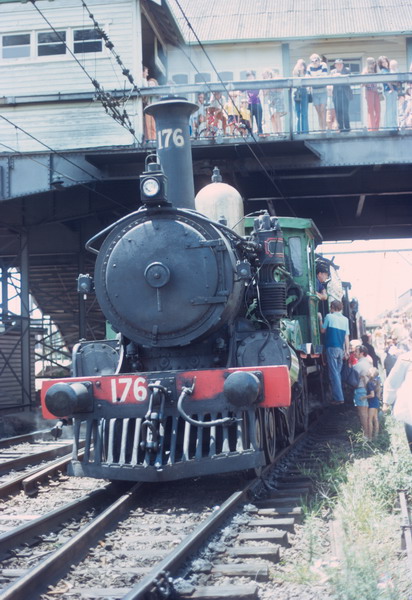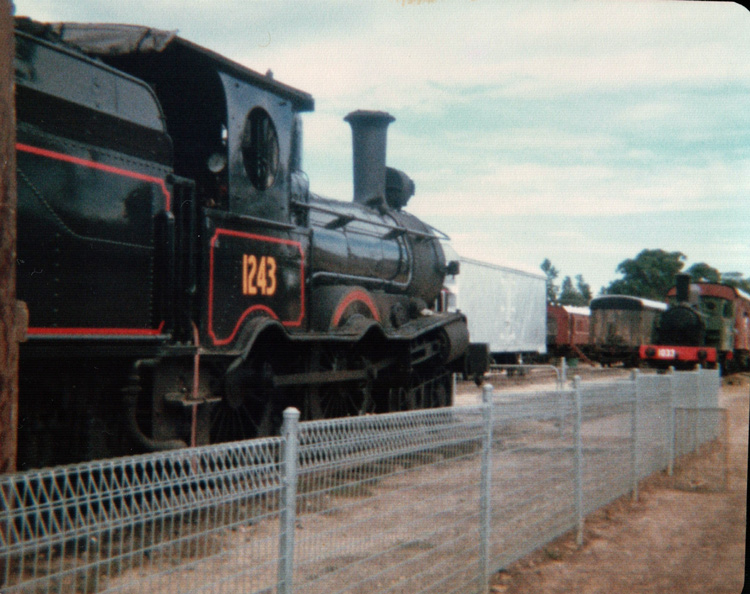|
|
1243 Powerhouse Museum exhibit |
|

1243
displayed in the Power House Museum, Sydney on 13 February 2005.
|
Builder |
Atlas Engineering Co, Pyrmont,
Sydney |
|
Builder’s Number & Year |
2 of 1882 |
|
Wheel Arrangement |
4-4-0 |
|
No. in class |
68 |
|
This
handsome locomotive entered traffic with the New South Wales Government
Railways (NSWGR) in February 1882 as C 176, one of 68 members of the C(79) class deployed on passenger and mail train
duties. Although designed by Beyer
Peacock & Co, Manchester, C 176 was one of 8 supplied by Sydney company
Atlas Engineering Co, Pyrmont under a government policy to stimulate the
local manufacturing industry. The
C(79) class were the mainstay of the NSWGR passenger locomotive fleet for
several years, being augmented in the mid-1880’s by inside cylinder 4-4-0
types on top expresses until superseded by more powerful 4-6-0 types from the
1890’s, following which the class found further use at country depots on rural
and secondary services. As
originally built, the C(79) class featured round-top
boilers with Salter safety valves, a sloping smokebox front, ornate
copper-top chimneys and open cabs.
They were later rebuilt with Belpaire boilers (retaining saturated
steam) and Ramsbottom safety valves, cast iron chimneys and enclosed steel
cabs of the “Thow” port-hole style. They were reclassified as (Z)12’s in the 1924 renumbering, with C 176 becoming
1243. (For further general information
about the C(79) / (Z)12 class, refer to the page for
sister 1210.) The
NSWGR withdrew most of its 4-4-0’s in the 1930’s following the arrival of the
(C)30T class and early petrol railmotors, however a
small number of (Z)12 class were retained for niche light line & country
duties. 1243 was among this number and
in 1955 was repainted to lined green livery for the NSWGR Centenary
celebrations at Central Station.
Together with 1210, it hauled the “Last Steam Train to Gosford” tour
of 23 January 1960 to mark the completion of electrification to Gosford. The success of this tour encouraged the
NSWGR to establish its “Vintage Train” operation in 1960, retaining 4-4-0’s
1243 and 1709 as historic motive power and photos of the period show the two
ageing locomotives often double-headed on tour trains around the state in
connection with local historical events. 1243 obtained a further degree of
stardom when selected for the 1970 film “Ned
Kelly” with Mick Jagger in the eponymous lead role, the Ned Kelly story
having significant railway link as his outlaw gang infamously set a trap with
the aim of derailing a special police train at Glenrowan,
Victoria. (The Ned Kelly plot gives an
interesting insight to the 1880’s zeitgeist, with railways bringing rapid
change as they spread through rural Australia and public awareness of some of
the risks of rail travel, particularly horror stories of derailments
involving wooden carriages. The Kelly
Gang sought to lure a special police train to the Victorian Town of Glenrowan and then derail the train on an embankment as
it sped downhill and around a corner on approach to the town, with the aim of
murdering the contingent of police travelling within. Today this plot would probably be called an
act of domestic terrorism!) 1243 was
rebuilt in 1969 in preparation for its movie role, receiving an extended smokebox
(following experience with 1219), a vintage copper-top chimney, cowcatcher,
green livery and its old number 176 restored to give the loco a more antique
appearance. The railway sequences were
filmed on the recently closed Captains Flat branch line, near Canberra, with
a location prepared to appear as Glenrowan railway
station. 1243 received a somewhat
larger P(6)-type 6 wheel tender at this stage, in
replacement of the original low-sided 6-wheel tender variety. 1243
continued in Vintage Train duties after Ned Kelly filming, retaining the
number 176 and green livery. Alas the
Vintage Train program was suspended in March 1974 as one of the rapid changes
to railway heritage following the creation of the Public Transport Commission
of NSW (PTC) but by this time 1243 was being cared for by the New South Wales
Rail Transport Museum (NSWRTM) at Enfield Roundhouse. Another change following the PTC was the
NSWRTM being evicted from Enfield Roundhouse and 1243 was transferred
to the new Thirlmere site in 1975, where it regularly featured on Loop Line
trains. A repaint to black livery, cast iron
chimney and renumbering to 1243 came in 1978.
1243 was withdrawn from the NSWRTM operational fleet in about 1982,
corresponding with the time larger and more utilitarian steam locos 3001T and
3642 had recently been returned to service. Some
early preservation literature lists sister 1219 as being set aside for the
Museum of Applied Arts & Sciences (now known as the Powerhouse Museum)
but at some stage it was swapped with 1243.
The development of the new Powerhouse Museum was a major NSW state
project in the 1980’s and 1243 was cosmetically restored to more authentic
condition
by the
NSWRTM (under contract) in preparation for display at the Powerhouse Museum, with lined black
livery, an original low-sided 6-wheel tender (Tab 208, originally paired with
loco 2504) and the short smokebox reinstated.
This work culminated in 1988 with 1243 placed on permanent display in
the transport hall of the Powerhouse Museum at Ultimo, Sydney, not far
from the site of the Atlas Engineering works where the loco had been built more
than 100 years previously. It is
displayed alongside the Governor’s
Carriage of 1891 vintage in a recreated station scene, which is rather
fitting given that this beautiful carriage was also first saved for
preservation via the NSWGR Vintage Train.
Some further information about 1243 can be found on the Powerhouse
Museum curatorial notes. |

The ornate Atlas Engineering Co builder’s plate above the
driving wheel splasher. 8 July 2015

1243 (as 176) in “Ned
Kelly” guise with extended smokebox, cowcatcher, copper chimney and green
livery.
176 is leading 1709 (as
381) on a typical 1970’s excursion working (date & location unknown) and
has drawn a crowd.
Both locomotives are
fitted with original handsome copper-top chimneys displaying loco number, as was
early NSWGR practice.
My thanks to Mike Adcock for contributing this view, from
his father’s slide collection.

A second view of 1709 (as
H 381) and 1243 (as C 176) on a typical 1970’s excursion working.
At this stage, both locomotives were paired with P(6) class tenders rather than their original types.

I have included this rather
poor scanned photo of 1243 at Thirlmere in 1978 because it is one of the first
photos I ever took!
At that stage I was 10
years old and using a 110mm film camera which (was little more than a toy).
1243 had recently been
repainted to lined black livery and renumbered 1243.
It is fitted with a cast
iron chimney but retains the extended smokebox and P(6)
tender, thus visually resembling 1219 in its latter years.
1243 was a regular performer on Loop Line services at
Thirlmere at this stage.

My thanks to John
Hurst (from an original by Phil Sullivan) for this view of 1243 & 1210
on “The Last Steam Train to Gosford” tour of 23 January 1960.
This tour celebrated the
opening of electrification to Gosford, replacing steam traction & assistant
engines on Cowan Bank.
The success of this tour led to the creation of the NSWGR Vintage
Train and the initial retention of 1243 and 1709.
References
|
a |
"Locomotives of Australia" by Leon Oberg,
published by J. W. Books Pty Ltd, 1982 reprint. |
|
b |
"A
Compendium of New South Wales Steam Locomotives" compiled by Alex Grunbach, published by the Australian Railway
Historical Society, New South Wales Division, 1989. |
|
c |
‘Steam
Locomotive Data’ July 1974 edition, compiled by J. H. Forsyth for the Public
Transport Commission of NSW. |
|
d |
Wikipedia
entry for the NSWGR (Z)12 class, retrieved 17
August 2015. |
|
e |
Webmaster's
observation or comment |
Page updated:
31 August 2015
|
Government Railways: |
|
|||||||||
|
Private & Industrial Railways: |
|